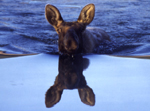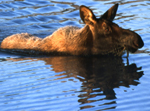Field Journal-Oxbow Bend
 |
 |
Cow Moose Swimming Across Oxbow Bend, Grand Teton National Park
© Thayne Shaffer 1996
Nikon N90 with 300mm f4.0 ED IF Lens
f4 @ 1/125 sec; Bogen Tripod
Kodak E100 VS film
Grand Teton National Park
October 16, 1996
It was well before dawn when my wife, brother, sister and I drove from our campsite at Signal Mountain to the popular scenic overlook at Oxbow Bend. Finding a good spot in the morning at Oxbow requires that you arrive extremely early. I chose a spot that would give me a clear view of the mountain’s reflection in the Snake River. Then I set my camera on the tripod and readied its settings. Soon I was surrounded by a van-load of photographers, all with antique-looking, large format cameras perched on heavy wooden tripods. Standing next to my relatively small Nikon N90, I couldn’t help but feel a little equipment envy.
Oxbow is one of the most photographed places in the world. However, in all my early-morning visits, I had never experienced a morning in which all the right conditions came together. But that morning I had hope. To the West a low bank of clouds drifted along the foot of the Tetons, their peaks rising majestically from the mist. The leaves on the aspens across the river were bright yellow. The water was smooth as glass. Everything seemed to be in order for the perfect photograph.
As I waited patiently, I watched a lone cow moose graze lazily along the opposite edge of the river. In my mind, I could see her slowly make her way to the perfect spot on the riverbank, just as the sun broke upon Mount Moran and ignited the aspen leaves in autumn color. But the eastern sky was dark, and I could see outlines of heavy clouds across the horizon. After a while, I concluded my beautiful photograph would have to wait for yet another morning. There were too many clouds in the East, and there would be no burst of brilliant sunlight on the aspen leaves or the misty mountains.
Finally, I packed up my gear and left the tangle of photographers. In an attempt to salvage the morning, I changed lenses and walked down to the water—directly across from the moose. No sooner had I set down my tripod, than she turned and waded into the river directly toward me. I quickly began to fire off exposures. As she slid deeper into the water, the sun peeked through the clouds and flooded the scene with a warm light that glittered in the frost still clinging to her back. As she drew nearer, I was forced to retreat up the bank, giving her room to leave the water right where I had been standing.
After she had moved down the river, I turned to head back up the trail and noticed a cluster of the photography students watching me from above, their bulky cameras still facing the dark mountains. One of them asked, “Did you get that?â€
I nodded and smiled. “Yes.â€


